|
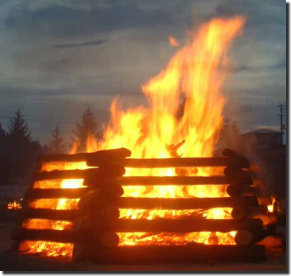
Central Bonfire at the Jomon Festival
The Japanese love festivals and one can be found in almost any town at some point during the summer months. Some are huge fireworks festivals, like the Sumida River Festival in Tokyo, while most are small local affairs that take place at village shrines. Many include parades, traditional music, karaoke contests, and street vendors selling items like goldfish, animation character masks, octopus "balls," and other assorted knickknacks and snacks. Some festivals are very focused on one theme, like the Jomon Fire Festival I recently attended in Iwate Prefecture.
Iwate Prefecture is in Japan's northern Tohoku region. That area was late in arriving on the ceramic scene with most kilns being established sometime in the Edo period -- examples would be the Nagaoka kiln in Akita, Aizu-Hongo in Fukushima, Hira-Shimizu in Yamagata, and Kuji in Iwate. Yet, when it comes to Jomon wares (pottery prior to 300 BC), the Tohoku region has many old sites where major Jomon works have been excavated. In a desire to keep the memory and tradition of Jomon alive, Fujisawa Town in Iwate began the Jomon Fire Festival 26 years ago.
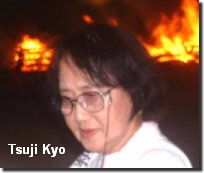 The late Jomon researcher Shiono Hanjuro planted the seed for the festival and had the help of local yakishime potter Honma Shinichi. Honma studied with the living legend Tokyo-based Shigaraki potter Tsuji Seimei and got him involved in promoting the festival. In addition, the late artists Okamoto Taro and Ikeda Masuo also became associated with the festival and now two of the three top awards are named after them, along with the Shiono Award. I was invited to go with Tsuji Kyo, Seimei's wife, one of the judges, and a fine ceramic artist as well. The late Jomon researcher Shiono Hanjuro planted the seed for the festival and had the help of local yakishime potter Honma Shinichi. Honma studied with the living legend Tokyo-based Shigaraki potter Tsuji Seimei and got him involved in promoting the festival. In addition, the late artists Okamoto Taro and Ikeda Masuo also became associated with the festival and now two of the three top awards are named after them, along with the Shiono Award. I was invited to go with Tsuji Kyo, Seimei's wife, one of the judges, and a fine ceramic artist as well.
After a four-hour train ride I arrived at the festival grounds just as dusk was descending. The "Jomon Boys" -- a group of local junior high school kids -- were lighting the ceremonial fire the old way. After about a twenty-minute wait, which saw the Jomon cheerleaders chanting and praying, the fire was lit.
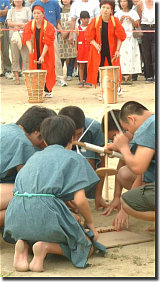 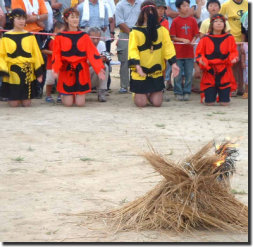
(L) Boys lighting ceremonial fire; (R) Jomon cheerleaders
A large center symbolic bonfire was ignited (see photo at top of page) and then the sixteen open-pit kilns that encircled the grounds were given a "fire life."
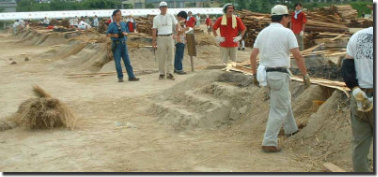
Pit before firing
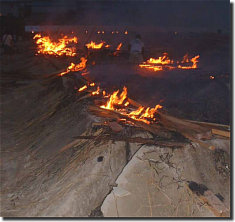
16 pit fires (click for larger photo)
A total of 1500 pieces were now being transformed into Jomon pottery. As evening fell the brilliance of the flames lit up the sky and it was a site to behold.
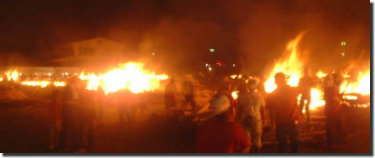
Night scene
It seemed like the whole town showed up with many folks wearing yukata and almost all taking part in the Jomon Odori Dance.
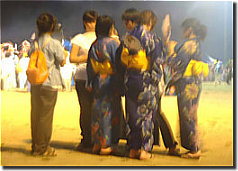
Girls wearing yukata
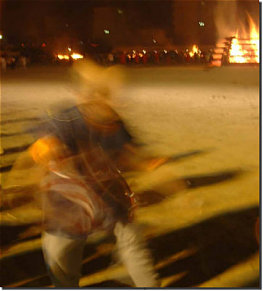
Jomon Odori Dance
Volunteers kept the pit temperature rising until it reached about 1000 Celsius after a few hours of stoking. This lasted until about midnight when the last stacks of wood were thrown on and the fires slowly died out.
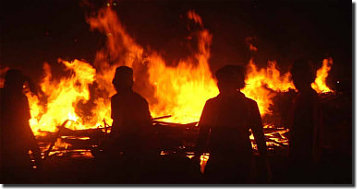
Stoking the fires
The next morning the works were unloaded and placed in a special area for the thirteen judges to view and select their choices. They made mostly cartoon characters with some trying in earnest to copy the dynamic works of the Jomon period.
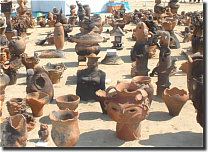
Some works from the pit fires (click for larger photo)
Most of the works were playful things made by local schoolchildren. I thought it was a wonderful way for them to be creative, participate in the firing, and find a connection with their ancient roots.
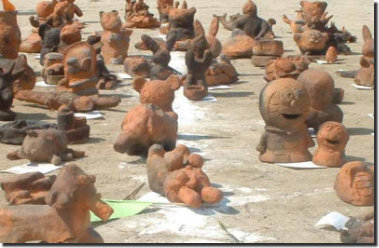
Pieces by the children
Many of the adults' work did capture the look and feel of the ancient pots, yet the judges were not interested in mere imitation. They were looking for the spirit in the work and chose the below work as one of the best in the show.
All in all it was a successful festival. The kids all had smiles as they hauled their creations home, as did I as I boarded my train back to Mishima -- fire images still dancing in my mind and thoughts of wonder at the original power and fascinating Jomon works, some fired over 10,000 years ago in the snow country of Japan.
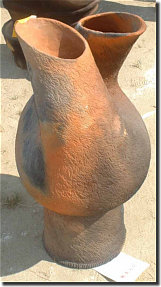
One of the award winners (click for larger photo)
LEARN MORE ABOUT JOMON
|